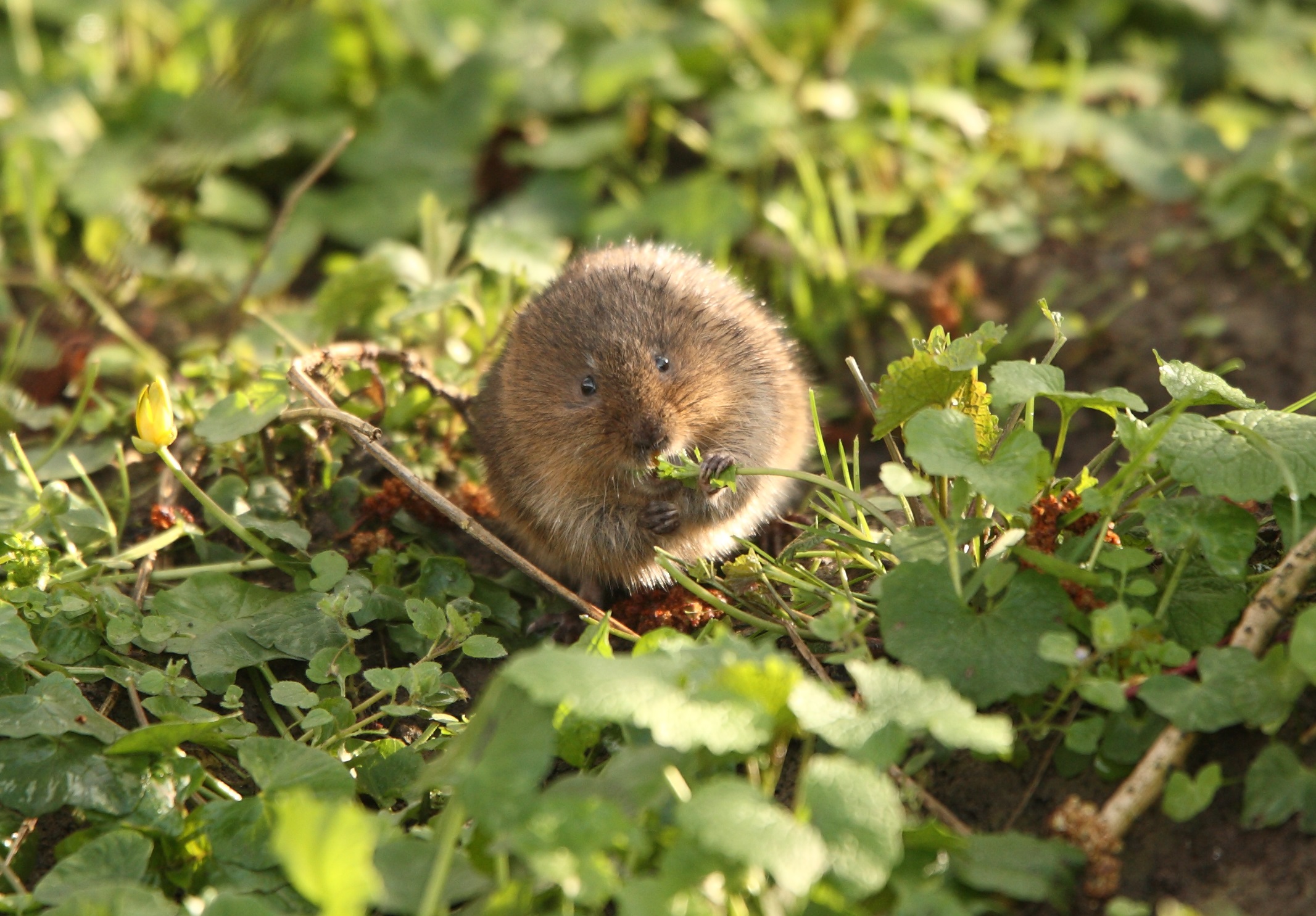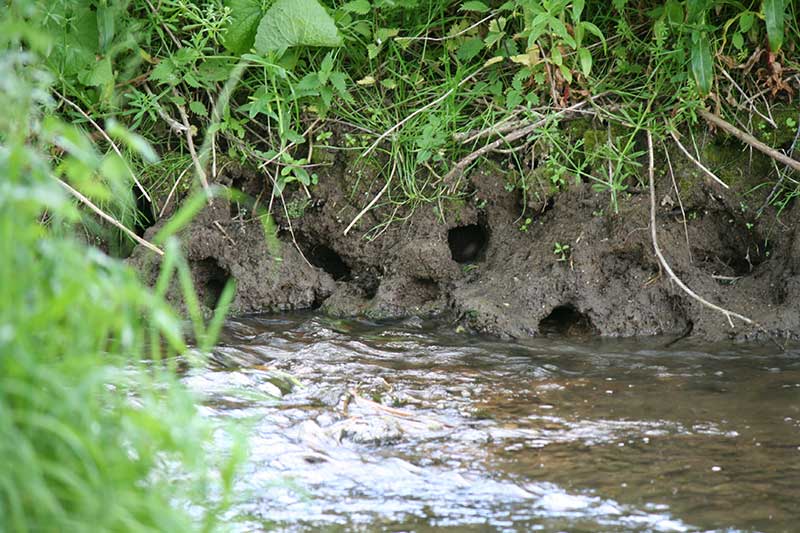Water vole

Status
Native and rare
Population
132,000
Scientific name
Arvicola amphibius
Water voles are the largest species of vole in Britain and are sometimes mistaken for brown rats, which can be found in a similar habitat. They are also sometimes commonly known as the water rat or water dog.
Head-body length: 12 – 20 cm
Tail length: About half the length of the body
Weight: Up to 300g
Lifespan: Few survive two winters
Water voles have glossy brown or black fur and a blunt muzzle with small, black eyes. Their ears are rounded and almost hidden, and they have a dark, slightly furry tail. They are mostly active during the day, sitting on their hind feet and feeding on grass stalks held in their front paws. If they are disturbed, they dive into the water with a characteristic ‘plop’ sound. When they swim, their head and back are visible.
Water voles have undergone one of the most serious declines of any wild mammal in Britain during the 20th century. The intensification of agriculture in the 1940s and 1950s caused the loss and degradation of habitat, but the most rapid period of decline was during the 1980s and 1990s as American mink spread. Between 1989 and 1998, the population fell by almost 90 per cent!
Reproduction
Starts in March and goes on until October. Females produce between two and five litters annually each of two to eight young. Young leave their mother after 28 days and those born in July may breed that autumn, though most reach sexual maturity after their first winter. Juvenile water voles need to weigh at least 170g to survive winter.
Diet
Reeds, grasses, rushes, sedges, water plants and wetland plants in the spring and summer and roots, rhizomes, bulbs and bark in the autumn and winter. Very occasionally insects and other invertebrates are eaten.
Habitat
Grassy banks along slow moving rivers, ditches, streams, lakes, ponds, canals, as well as marshland and upland. They dig burrows in steep grassy banks, which often include underwater entrances.
Habits
Water voles live in colonies but string themselves out along a watercourse. Breeding females have territories of 30-150m and fiercely defend them, while males have larger home ranges of 60-300m that overlap those of several females. Females mark their territories using discrete latrine sites, close to the burrows and at the boundaries. Latrines are flattened piles of droppings topped with fresh ones.
Water voles are active during the day. They do not hibernate over winter but do spend more time in their burrows, often cohabiting with members of the same colony and so are less visible above ground.
Predators
Mink, foxes, otters, stoats, weasels, owls, herons, marsh harriers, pike, brown rats and cats. Golden eagles in the Scottish Highlands.
Threats
Water voles used to be found in nearly every waterway in England, Scotland and Wales but are now thought to have been lost in up to 90% of these sites. Threats include habitat loss and fragmentation from unsympathetic riverside management, predation by non-native American mink and pollution.
Habitat loss and degradation
Urbanisation of floodplains and a general increase in development have led to the direct loss of habitat and the loss of riverside vegetation. Heavy grazing by livestock not only causes the loss of riparian vegetation but also the poaching and trampling of banks, making them unsuitable for water voles. Inappropriate management of both the waterside vegetation and the channel itself can also lead to the loss of water voles from the waterway. Flooding and drought both cause population declines, with drought being the more serious threat as it leaves them very vulnerable to predation. Sympathetic management of both the waterway and its banks can enhance the suitability of the habitat for water voles.
Pollution
It remains largely unknown what effect the large amounts of pollutants, such as pesticides, farm waste and chemicals, that used to enter rivers and waterways in the past had on water voles, though it could have led to a direct decline in numbers. In recent years, tighter legislation and better pollution advice have led to improved water quality throughout Britain. This has led to the return of otters to every county, which directly compete with and often remove introduced American mink.
Predation
Water voles are particularly vulnerable to predation by American mink which were first brought to Britain in the 1920s for fur farms, they began escaping very quickly and were breeding in the wild by the mid-1950s. The water vole’s usual defence of diving underwater and kicking up a screen of dirt or running into their burrow are insufficient against mink. A female mink can fit into water vole burrows and can wipe out entire colonies and populations along water ways. Mink are currently being controlled on many waterways across Britain and hopefully this should alleviate the predation pressure on many local populations of water voles.
Population fragmentation
As the amount of suitable habitat declines and local populations go extinct water voles become vulnerable to population fragmentation, increasing the rate of local decline. Small isolated populations can also become vulnerable to a loss of genetic variation. Increased connectivity between populations, allowing range expansion and dispersal is needed for the survival of local populations. This can be achieved through habitat enhancement and restoration to areas adjacent to remaining colonies.
Conservation status
GB Red List: Endangered (EN) in England and Wales and Near Threatened (NT) in Scotland. Water voles are fully protected under section 9 of the Wildlife and Countryside Act 1981 (as amended). Schedule 5 of this Act makes it an offence to intentionally damage or obstruct access to water vole burrows.
Population size and distribution
GB population: 132,000. Formerly widespread and common in England, Wales and Scotland, ranging from Cornwall to the extreme north-east of Scotland. They are still widespread but patchily distributed, and have undergone one of the largest declines of any mammal in Britain. This long-term decline has continued in the last 20 years.
Water voles absent from Ireland and most British offshore islands except Anglesey, the Isle of Wight and the Sound of Jura Islands.
Did you know?
- Scottish water voles have a completely different ancestry from their English and Welsh cousins. Voles south of the border originate from water voles from south east Europe who recolonised Britain following the last Ice Age, whereas Scottish voles are descended from migrants from the Iberian peninsula.
- Water voles need to eat 80% of their body weight every day.
- Water voles in Britain have been recorded eating 227 different species of plant.
- Despite their name, in mainland Europe water voles often don’t live near water, instead they live underground like a mole. Outside of the UK they can occur at huge densities of 200-500 per hectare, enough to sometimes become an agricultural pest.
- There are a couple of known populations of water voles in Britain who don’t live near water – one population in Glasgow lives in an area of rough urban grassland with no open water nearby, they create extensive burrow systems and forage mainly above ground in a similar fashion to field voles.
- Water vole droppings aren’t scented, instead to scent mark their territories they rub their hind feet on the scent glands on their chest and then stamp them on their droppings, resulting in ‘trampled latrines’.
Record water voles with us
Anyone can take part in our national monitoring programme for water voles. View more details here.


